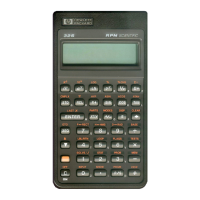5.
Key
in the rotation angle T and press IR/s
I.
6. To translate from the old system to the new system, continue
with instruction step 7.
To
translate from the new system to the
old system, skip to step 12.
7.
Press
fxEQl N to
start
the
old-to-new
transformation
routine.
8. Key in X and press I
R/S
I.
9.
Key
in
Y,
press
flTsl, and see the
x-coordinate,
U,
in the new
system.
10.
Press fR/sl
and
see the y-coordinate, V, in the new system.
11. For another old-to-new transformation, press I
R/S
Iand go to
step 8.
For
a
new-to-old
transformation,
continue
withstep 12.
12.
Press
fXEQl
O to
start
the
new-to-old
transformation
routine.
13.
Key
in U (the
x-coordinate
in the new
system)
and
press
IR/s
I.
14.
Key
in V(the
y-coordinate
in the new
system)
and
press
IR/SI
to
see
X.
15.
Press
Ir/sI
to
see
Y.
16. For another new-to-old transformation, press I
R/S
Iand go to
step
13.
For
an
old-to-new
transformation,
go to step 7.
Variables
Used:
M The x-coordinate of the origin of the new system.
N The y-coordinate of the origin of the new system.
T The rotation angle, 0, between the old and new
systems.
X The x-coordinate of a point in the old system.
Y The y-coordinate of a point in the old system.
U The x-coordinate of a point in the new system.
V The y-coordinate of a point in the new system.
Remarks: For translation
only,
key zero for
T.
For rotation
only,
key
zero
for
M
and
N.
Example: For the coordinate systems shown below, convert points
Pv
P2,
and
P3,
which
are
currently
in the
(X,Y)
system,
to
points
in
the
(X',Y')
system.
Convertpoint
P\,
whichis in the
(X',Y')
system,
to
the
(X,Y) system.
12:
Mathematics
Programs
201

